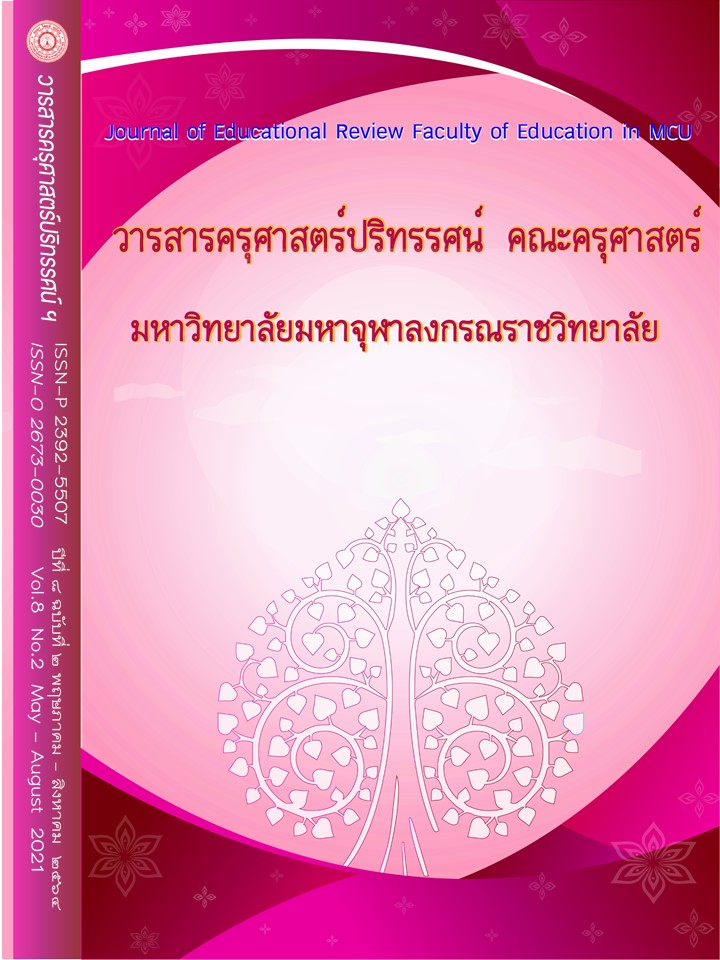THE ORGANIZATIONAL HIGH PERFORMANCE DEVELOPMENT MODEL BASED ON BUDDHIST PSYCHOLOGY IN MAHACHULALONGKORNRAJAVIDYALAYA UNIVERSITY
Main Article Content
Abstract
The objectives of this research article were (1) to study the high performance organization in Mahachulalongkornrajavidyalaya University, (2) to improve the organizational high performance development model based on Buddhist Psychology in Mahachulalongkornrajavidyalaya University, (3) to propose the organizational high performance development model based on Buddhist Psychology in Mahachulalongkornrajavidyalaya University. This qualitative research used methods of data collection : 1) document analysis, 2) interview with 11 executives and 17 experts, and 3) focus group with 9 persons. Moreover, this study used content analysis. The findings of the study were 1) the high performance organization of Mahachulalongkornrajavidyalaya University had 7 characteristics of objectives that were the University Image of strategic leadership, (2) effective quality management, (3) good governance principles, (4) mission networking with other organization, (5) learning organization, (6) organization with strong distinct corporate culture, (7) using modern technology and communication. 2) The improvement of the organizational high performance development model based on Buddhist Psychology in Mahachulalongkornrajavidyalaya University that was the improvement planning to reach 7 high-performance characteristics by the process of personal behavioral development as Buddhist Psychology in Mahachulalongkornrajavidyalaya University, for example, to set the team goals for work, readiness for word as roles, responsibilities and challenging situations, and motivation for the success of the work as Conbach’s theory. In addition, reinforcing Iddhipada 4 for willingness to work successfully, and creating the characteristics as Brahmavihara 4 for generosity to help each other and Sangghahavatthu 4 for harmony and reconciliation in organization. Moreover, 3) the organizational high performance development model based on Buddhist Psychology in Mahachulalongkornrajavidyalaya University was composed of 3 processes : 1) to set objectives, set objectives, guidelines of development planning for being 7 high performance characteristic organization, 2) to create the process of personal behavioral development as Buddhist Psychology and (3) to work together as development planning for being high-performance organization based on 7 characteristic aspects according to MCU HPO model.
Article Details
ทัศนะและความคิดเห็นที่ปรากฏในบทความในวารสารฉบับนี้ถือเป็นความรับผิดชอบของผู้เขียนบทความนั้นเพียงผู้เดียว และไม่ถือเป็นทัศนะและความรับผิดชอบของกองบรรณาธิการ
กองบรรณาธิการขอสงวนสิทธิ์ในการคัดเลือกบทความลงตีพิมพ์และจะแจ้งให้เจ้าของบทความทราบหลังจากผู้ประเมินบทความตรวจอ่านบทความแล้ว
ต้นฉบับที่ได้รับการตีพิมพ์ในวารสารครุศาสตร์ปริทรรศน์ คณะครุศาสตร์ มหาวิทยาลัยมหาจุฬาลงกรณราชวิทยาลัย ถือเป็นกรรมสิทธิ์ของคณะครุศาสตร์ มหาวิทยาลัยมหาจุฬาลงกรณราชวิทยาลัย ห้ามนำข้อความทั้งหมดหรือบางส่วนไปพิมพ์ซ้ำ เว้นเสียแต่ว่าจะได้รับอนุญาตจากมหาวิทยาลัยฯ เป็นลายลักษณ์อักษร
References
กฤตนัย ชัยมูล และคณะ. (2564). ความสำคัญของการศึกษา. แหล่งที่มา https://sites.google.com/site/mungreiynpheiyrfiru/khwam-sakhay-khxng-kar-suksa สืบค้นเมื่อ 25 ม.ค. 2563.
กองแผนงาน สำนักงานอธิการบดี มหาจุฬาลงกรณราชวิทยาลัย. (2561). แผนพัฒนามหาวิทยาลัยมหาจุฬาลงกรณราชวิทยาลัยในช่วงแผนพัฒนาการศึกษาระดับอุดมศึกษา ระยะที่ 12. แหล่งที่มา http://plandiv.mcu.ac.th/?p=3122 สืบค้นเมื่อ 25 ม.ค. 2563.
ชวนพิศ สิทธิ์ธาดา. (2552). รูปแบบสมรรถนะของผู้บริหารสถานศึกษาขั้นพื้นฐานที่มีประสิทธิผล. ดุษฎีนิพนธ์ปรัชญาดุษฎีบัณฑิต. มหาวิทยาลัยศิลปากร.
มยุรี คำปาเชื้อ. (2557). รูปแบบการบูรณาการหลักพุทธธรรมเพื่อการพัฒนาบุคลากรสายสนับสนุนวิชาการของมหาวิทยาลัยราชภัฏในกรุงเทพมหานคร. ดุษฎีนิพนธ์พุทธศาสตรดุษฎีบัณฑิต. มหาวิทยาลัยมหาจุฬาลงกรณราชวิทยาลัย.
มหาวิทยาลัยจุฬาลงกรณราชวิทยาลัย. (2539). พระไตรปิฎกฉบับภาษาไทย ฉบับจุฬาลงกรณราชวิทยาลัย. กรุงเทพมหานคร: โรงพิมพ์มหาจุฬาลกรณราชวิทยาลัย.
วาสนา เลิศมะเลา และเทพศักดิ์ บุณยรัตพันธุ์. (2561). การพัฒนาองค์การสู่ความเป็นเลิศของมหาวิทยาลัยราชภัฏในเขตพื้นที่ภาคตะวันออกเฉียงเหนือ. วารสารรัฐศาสตร์และรัฐประศาสนศาสตร์. 9(2).
ศศิรัศมิ์ ประสาทแก้ว. (2556). ปัจจัยเชิงสาเหตุพหุระดับในการพัฒนามหาวิทยาลัยสู่องค์กรสมรรถนะสูงแบบบูรณาการพหุมิติ ศึกษากรณีมหาวิทยาลัยวลัยลักษณ์ มหาวิทยาลัยทักษิณและมหาวิทยาลัยสงขลานครินทร์. ดุษฎีนิพนธ์การศึกษาดุษฎีบัณฑิต. มหาวิทยาลัยทักษิณ.
สมหมาย เทียนสมใจ. (2556). รูปแบบการบริหารงานที่มีประสิทธิภาพของสำนักงานเขตพื้นที่การศึกษาประถมศึกษา. ดุษฎีนิพนธ์ปรัชญาดุษฏีบัณฑิต. มหาวิทยาลัยศิลปากร.
สำนักงานคณะกรรมการการอุดมศึกษา. (2560). กรอบแผนอุดมศึกษา ระยะยาว 15 ปี ฉบับที่ 3 (พ.ศ. 2560 – 2574). กรุงเทพมหานคร: สำนักงานคณะกรรมการการอุดมศึกษา.
สุริยะ ทวีบุญญาวัตร. (2559). รูปแบบองค์กรสมรรถนะสูงของโรงเรียนมัธยมศึกษาสังกัดสำนักงานคณะกรรมการการศึกษาขั้นพื้นฐาน. ดุษฎีนิพนธ์ครุศาสตรดุษฎีบัณฑิต. มหาลัยศิลปากร.
BT CORPORATION. (2563). องค์การที่มีประสิทธิภาพสูงด้วยวัฒนธรรม 7 ประการ. สืบค้นเมื่อ http://www.bt-training.com/index.php?lay=show&ac=article&Id=2147548285&Ntype=1 สืบค้นเมื่อ 18 ม.ค. 2563.
HR NOTE.asia. (2562๗. อุปสรรคของการทำงานระบบทีมและการบริหารความขัดแย้งที่เกิดขึ้นภายในทีม. แหล่งที่มา https://th.hrnote.asia/orgdevelopment/190510-team-conflict-management/ สืบค้นเมื่อ 18 ม.ค. 2563.
Edmond, R. R. (1979). Effective school for the urban poor educational leadership educational. Leadership. 37(1).


